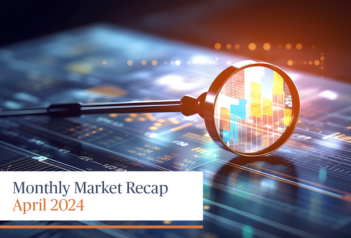The Russian invasion of Ukraine sent shockwaves around the world resulting in swift condemnations and heavy sanctions. There was little effect here, beyond the political proclamations from Washington, D.C.
The stock market managed an amazing comeback last week. The deteriorating Russia-Ukraine situation sparked an initial selloff, then rallied on optimism that the conflict could have only a minimal impact on the U.S. economy. The S&P 500 closed the week with a 0.8% gain after falling as much as 5.5%. The Nasdaq Composite increased 1.1% after plunging as much as 7%.
The turnaround came after President Joe Biden issued targeted sanctions that did not affect Russia’s oil and gas exports. Given current events, one of the biggest tests of the week will be the decision on Wednesday by OPEC+ on potential production boosts. As a reminder, Russia and Saudi Arabia dominate global production, each responsible for over 10 million barrels/day1. Biden’s first State of the Union address comes Tuesday evening.
Over the weekend though, the U.S., United Kingdom, and European Union jointly agreed to put crippling sanctions on the Russian financial sector, including a limited block on its access to the global SWIFT financial system. SWIFT moves countless billions of dollars daily between more than 11,000 banks and other financial institutions around the world.
As we have highlighted before, geopolitical events create short-term volatility and market drawdowns, but also long-term opportunities.
The uncertainty of a war in Europe could similarly discourage the Federal Reserve from being aggressive about hiking interest rates, which had been weighing on stocks before Russia’s invasion.
The next Fed meeting is March 16, and the probability of a 50-basis points rate hike, instead of just 25, had moved up significantly after the January inflation data. Odds are now for a 25-basis points hike after the start of invasion. While the situation in Ukraine is tragic and will remain in the headlines for weeks and months to come, in terms of markets, the bigger story of 2022 is still about rising rates. The Fed is facing the challenge of combatting inflation without prompting too big of a hit to economic growth.
Rising commodity prices, along with post COVID-19 labor trends, should continue to make inflation readings elevated well into 2023. Real rates are still very negative, and the potential for a U.S. dollar liquidity squeeze globally could make the monetary situation murkier for the Fed to navigate. Energy costs are a very important ingredient for all goods. With the massive push to green energy, oil companies will have a difficult time approving any long-term exploration and energy costs could stay high longer than expected.
The specter of stagflation — the combination of low economic growth and high inflation — is making some investors and asset managers rethink portfolio construction and asset allocation. Stagflation is associated with the recessionary period of the 1970s. There are differences compared to today. First, we do not have high unemployment. Our labor participation rate is still recovering from 2020. Second, the makeup of the economy is vastly different. Nearly half of the companies that were Dow components back then are no longer in the Dow. Some no longer exist. Third, poor policies enacted back then — including the collapse of the Bretton Woods currency system — magnified the economic stress of the mid-70s. While stagflation is just one possible scenario, we build our portfolios with strategies that can benefit from multiple economic outcomes.
Many ETFs are based on momentum and have little inflation exposure, making them poorly equipped for this environment. Staying invested in a diversified portfolio, of active and passive strategies, has paid off through countless geopolitical crises and should continue to do so. Ultimately, portfolios should benefit from quality stocks with durable profits and fixed income for stability. We are not advocating for broad rebalancing currently, but rather are seeking balance between value versus growth and the U.S. versus international stocks. Diversification will remain key as we ride out this volatility.
If you have any questions or want to have a conversation about the market or your portfolio, please contact Liz, Ed, Fred, Scott, Tyler, or myself. Your Sendero team is ready to help.
Best Regards,
Amaury de Barros Conti, Partner | Vice President Investments
210-930-9409
aconti@sendero.com
1S&P Global, Energy & Oil Insight Blog, February 22, 2022.


